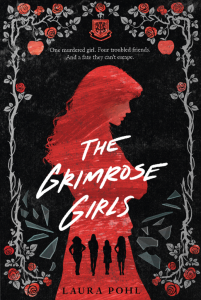
Book: “A Lesson in Vengeance” by Victoria Lee
Publishing Info: Delacorte Press, August 2021
Where Did I Get This Book: The library!
Book Description: Felicity Morrow is back at Dalloway School.
Perched in the Catskill mountains, the centuries-old, ivy-covered campus was home until the tragic death of her girlfriend. Now, after a year away, she’s returned to graduate. She even has her old room in Godwin House, the exclusive dormitory rumored to be haunted by the spirits of five Dalloway students—girls some say were witches. The Dalloway Five all died mysteriously, one after another, right on Godwin grounds.
Witchcraft is woven into Dalloway’s history. The school doesn’t talk about it, but the students do. In secret rooms and shadowy corners, girls convene. And before her girlfriend died, Felicity was drawn to the dark. She’s determined to leave that behind her now; all Felicity wants is to focus on her senior thesis and graduate. But it’s hard when Dalloway’s occult history is everywhere. And when the new girl won’t let her forget.
It’s Ellis Haley’s first year at Dalloway, and she’s already amassed a loyal following. A prodigy novelist at seventeen, Ellis is a so-called “method writer.” She’s eccentric and brilliant, and Felicity can’t shake the pull she feels to her. So when Ellis asks Felicity for help researching the Dalloway Five for her second book, Felicity can’t say no. Given her history with the arcane, Felicity is the perfect resource. And when history begins to repeat itself, Felicity will have to face the darkness in Dalloway–and in herself.
Review: You give me a YA thriller that involves a boarding school with a bloody history, and I am one hundred percent here for that kind of narrative. And if you throw in witches, or even the rumor of them, I’m even MORE interested. So obviously when I read about “A Lesson in Vengeance” by Victoria Lee, I definitely wanted to give it a read.
The thing that worked best in “A Lesson in Vengeance” was the eerie setting and atmosphere of Dalloway School, the prestigious boarding school that our protagonist Felicity attends. It has a long history of educating women, but a notorious past involving five students who were supposed witches, and who died under strange circumstances. Lee builds this history up through Felicity’s perspective, as well as research that she and new student/prodigy author Ellis are conducting. We know that Felicity has been through some kind of trauma involving her former girlfriend Alex, who also died, and whose death is haunting Felicity for various reasons. As she and Ellis start to dig into the occult rumors, the tension builds at a well paced rate. I was definitely wondering just what Felicity was hiding, both from the reader as well as herself, and while I kind of figured out some of (okay, a lot of) the twists and reveals that we had along the way, the creepy setting and atmosphere that Lee had in place made the journey work for me. I also thought that the tension between Felicity and Ellis was nice and taut, as they are playing a game of sexual and romantic desire and want, while also perhaps not being able to trust each other for various reasons that are slowly peeled back as the book goes on.
But that brings us to the characters themselves. “A Lesson in Vengeance” has a harder time with keeping the characters interesting as the story goes on, as I felt that both Felicity and Ellis were pretty two dimensional. Or at the very least, tropey in their characterizations. Felicity is the unreliable poor little rich girl, whose toxic relationship with her now dead ex girlfriend has damaged her, but also perhaps has her hiding something. Ellis is the cold and blunt child prodigy whom everyone loves due to her fame (as she is a published author) but who is also potentially hiding secrets and ulterior motives. They have a slow building romance that may or may not be dangerous, but it isn’t anything we haven’t seen before in thrillers where characters are potentially fatales, femme or otherwise. The tension is there, and it is effective, but at the end of the day neither Felicity nor Ellis had much unique to their characters, and came off more flat than anything else.
“A Lesson in Vengeance” is definitely an effective Dark Academia thriller, but it doesn’t reach the high levels I was hoping for.
Rating 6: A creepy and atmospheric thriller involving a history of witches, dangerous romance, and a school full of secrets. The characters, however, are a little flat for the tale they inhabit.
Reader’s Advisory:
“A Lesson in Vengeance” is included on the Goodreads lists “Dark Academia”, and “2021 Sapphic Releases”.
Find “A Lesson in Vengeance” at your library using WorldCat, or at a local independent bookstore using IndieBound!











